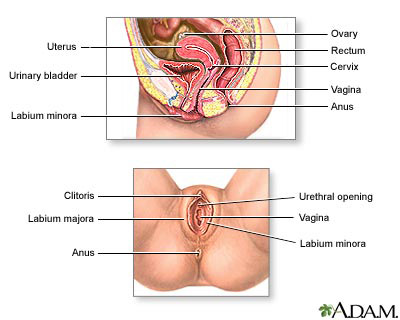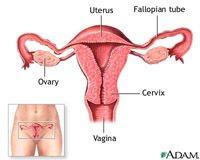Female AnatomyExternal Female Sex OrgansMany people refer to the female external organs as the ‘vagina', but this is anatomically incorrect, the more accurate term for the whole area would be the vulva or pudendum. The vulva is made up of the mons veneris, the labia majora, the labia minora, the vestibule, the perineum, and the clitoris. The vagina opens into the vulva, but it is mainly an internal organ.
Mons VenerisThe mons veneris or mons punis is the fatty cushion resting over the front surface of the pubic bone. This area is covered with pubic hair after puberty and serves as a protective cushion for the genitals especially during lovemaking. Labia MajoraThe labia majora are the outer lips of the vulva. They are two longitudinal folds of fatty tissue that start from the mons, cover the rest of the female genitalia and meet at the perineum. The skin of the outer layer of the labia majora is pigmented and covered with hair, whereas the inner layer is hairless and contains oil glands. During sexual excitement and arousal the labia majora fill with blood and engorge. Because the labia majora are homologous to the male scrotum, the sensation of caressing this area may be similar to that of caressing the scrotum in males. Labia MinoraThe labia minora are the inner lips of the vulva. They are the two smaller pink skin folds situated between the labia majora and the vestibule. They join at the clitoris and to form the prepuce, the ‘hood' over the clitoris. The labia minore have no hair follicles, but they are also rich in oil glands. Additionally, they contain erectile tissue and serve to protect the vagina and urethra. The ClitorisThe clitoris is a small cylindrical erectile tissue, homologous to the penis, and is supplied with blood vessels and nerve endings. Even though the clitoris is much smaller than the penis, it has twice the amount of nerve endings than the penis and is the only human organ whose sole purpose is to bring sexual pleasure. The VestibuleThe vestibule is the entire region between the labia minora and it contains the opening of the urethra and vagina and the ducts of Bartholin's glands (the greater vestibular glands). The PerineumThe perineum is the tissue between the vagina and the anus. During childbirth it may stretch or tear. Internal Female Sex OrgansThe female internal sex organs include the vagina, uterus, fallopian tubes, and the ovaries. The vagina is a thin-walled tube extending from the cervix of the uterus to the external genitalia. Its purposes are to serve as the female organ of intercourse, a passage for sperm, and a canal to which menstrual fluids and babies can pass from the uterus. The ‘G' SpotThe G-spot (Grafenberg Spot), as well as female ejaculation, are two controversial issues in human sexuality. The G spot is a small spot in the lower third on the front side of the vagina. This area is particular sensitive to stimulation. Some argue though that the entire wall of the vagina is sensitive and others argue that the G-spot is homologous to the male prostate. Stimulating the G-spot can result in orgasms that are accompanied by fluid, which is referred to as female ejaculation. However, some researchers argue that female ejaculation is chemically not different from urine.
|
|
Copyright © 2010 – 2023 Sexual Health Australia. All Rights Reserved. Powered by Sitesuite


 The Uterus
The Uterus
